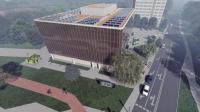On the path to energy self-sufficiency

Visualization of the installation on the roof of the Faculty of Materials Science and Engineering building featuring energy storages, photovoltaic panels, an LED banner, parking lot, and charger for charging electric cars, design: Ewa Kuhnert
Can a university building be energy self-sufficient? Our researchers are implementing a project to verify this. A pilot installation will be located on the roof of the Faculty of Materials Science and Engineering building.
– The idea originated from my doctoral student, Gabriela Komorowska, who participated in classes at the Faculty of Physics. They focused on selecting optimal methods for storing energy in the context of the requirements of structures such as the Faculty of Materials Science and Engineering building – says Prof. Tomasz Wejrzanowski, Vice-Dean for General Affairs and Research of this Faculty, and the project coordinator. – Together with her colleague from the Faculty of Chemistry, Martyna Smolarek, they proposed an installation based on a flow battery and sought to implement this solution in some way. Together with other deans, we embraced the idea, expanding it to include other battery storage techniques and technologies – he adds.
Researchers from five faculties of the Warsaw University of Technology are involved in the project: Materials Science and Engineering, Electrical Engineering, Physics, Chemistry, and Architecture. The team consists of both experienced professors and doctoral students, offering development opportunities for all researchers.
The project titled "Pilot installation of energy generation and storage based on efficient and durable photovoltaic and battery technologies" was qualified for the first stage of the STRATEG PW competition, carried out under the "Excellence Initiative - Research University" program. The focus of the proposed ideas was on developing and implementing solutions aimed at optimizing the energy efficiency of the Warsaw University of Technology.
Between January and July 2023, the preparatory and conceptual phase took place. Researchers designed an installation consisting of three systems utilizing lithium-ion batteries (including oxide and phosphate types) and flow batteries, connected to photovoltaic panels.
The photovoltaic micro-power plant will be situated on the roof of the Faculty of Materials Science and Engineering building. This decision was made based on technical capabilities and sunlight conditions.
– We conducted advanced energy consumption measurements. It turned out that the building consumes an average of about 50 kWh per hour. This is quite a lot. In comparison, a single-family house consumes about 5-10 kWh per day – explains Prof. Tomasz Wejrzanowski.
As part of the system, researchers also plan to install chargers for electric devices such as cars, bicycles, and scooters. They aim to make these available to university staff.
They have also established cooperation with external partners. In May 2023, they signed an agreement with Stoen Operator, which is interested in cooperation between the planned energy storage and the city's grid as part of shaping the flexibility service, involving methods for stabilizing the power grid. The team also collaborates with Polish battery manufacturing companies that are seeking opportunities for technology development and exploring new areas of application.
At the end of last year, the project entered the second stage of the STRATEG PW competition and will be implemented until October 2025. During this time, investment work will be carried out, including the construction of a photovoltaic installation covering the entire roof of the Faculty of Materials Science and Engineering building, along with the installation of three battery systems. In the research phase, scheduled for a later stage, researchers will analyze their operation to develop optimal solutions in terms of energy efficiency and durability, which could be used in the future as part of the infrastructure of the Warsaw University of Technology.
The team consists of: Prof. Tomasz Wejrzanowski from the Faculty of Materials Science and Engineering, Prof. Jacek Rąbkowski from the Faculty of Electrical Engineering, Michał Marzantowicz, PhD, associate professor from the Faculty of Physics, Aldona Zalewska, PhD, associate professor from the Faculty of Chemistry and Radosław Achramowicz, PhD, associate professor from the Faculty of Architecture. In addition to experienced researchers, young staff and doctoral students of the Warsaw University of Technology are also involved in the project.







